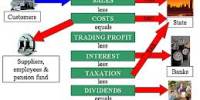A flexible budget is one that adjusts or flexes in response to changes in volume or activity. A flexible budget is more advanced and useful than a static budget. The flexible budget will flex for costs that vary with volume or activity because it includes a variable rate per unit of activity rather than a single fixed total amount. In short, when measuring a manager’s efficiency, a flexible budget is a more useful tool.
It is useful for both planning and controlling purposes, and it is commonly used to estimate factory costs and operating costs. A flexible budget is much more realistic than a fixed budget because it focuses on cost behavior at different levels of activity.
Types of flexible budget – These are the three different types of flexible budgets. Depending on the needs of the company, a company can create several variations of a flexible budget that range from basic to sophisticate. The following are the three types of flexible budgets most commonly used:
- Basic flexible budget
Expenses that vary with revenue are expressed as a percentage of sales or as a cost per unit in this budget and are adjusted as the output level changes. This budget flexes in response to a company’s expenses, which vary directly in relation to its revenue. A basic budget may include a variable percentage based on revenue. This budget is typically used to denote cost per unit or sales percentage.
- Intermediate flexible budget
An intermediate flexible budget accounts for expenses that exceed a company’s revenue. Typically, this budget includes activity-related costs in addition to or instead of revenue. For example, the cost of a company’s insurance policy may vary depending on how many employees it has and may rise if the company hires new employees.
Some expenses do not vary with revenue, but rather with some other measure, such as electricity expense based on the number of units consumed. An intermediate flexible budget considers changes in expenses based on such other activity measures.
- Advanced flexible budget
This budget considers the variations and ranges of expenses based on each category of a company’s budget. A flexible advanced budget will also change based on actual expenses for each category.
Furthermore, there are expenses that remain constant at a certain level of activity but change above that level. An advanced flexible budget considers changes in expenses based on changes in such levels.
















